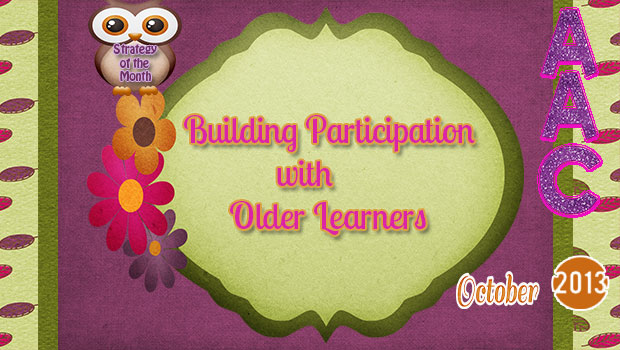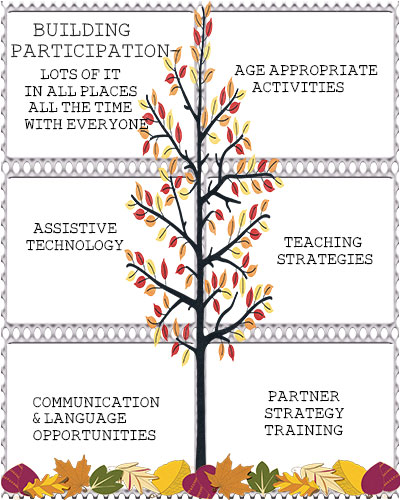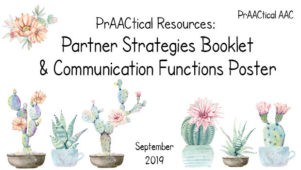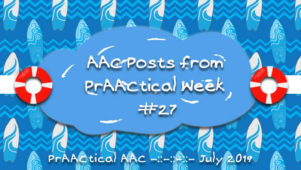Building Participation with Older Learners

We love active participation for communication and language learning. Actually, we love active participation in all areas of life for us, for our students, for everyone. When Carole introduced the Building Participation Strategy of the Month, she discussed the role of the Participation Model (Beukelman & Mirenda, 1988; 2013). The Participation Model is a framework for understanding the barriers to participation and then from a prAACtical intervention standpoint developing strategies and activities to increase active participation in a variety of (ALL) aspects of life.
For the 2012 AAC Awareness Month, we discussed barriers to participation. This year’s focus is on activities and strategies for getting past the barriers to building age appropriate authentic active participation for ALL learners. We have learned that when older learners with significant communication challenges are provided with age appropriate activities and supports, they can be engaged and motivated to participate and can often surprise us with ALL that they can do.
AAC Active participation involves all modalities of language: Talking, Listening, Reading & Writing. We will discuss communication experiences that allow for interaction within all of these language modalities.
Reasons for Communication:
- Requesting actions
- Requesting objects
- Protesting
- Calling someone
- Showing off
- Acknowledging
- Asking questions
- Requesting clarification
- Giving information
- Explaining
- Complaining
- Venting
- Tattling
- Joking around
- And much more…
Participation Activities for the Learner
- Sign in with: “here”, name stamp, or label or check off system.

- Getting Materials Independently– Students review their schedules and get their own materials rather than having it ready for them in a speech session. You can use a plastic rolling drawer set or folder system. If they can not physically get their materials, then they can “tell” the clinician what to get them by looking at schedule.
- Have small talk written into a schedule.
- Use AND prAACtice conversation attention getters and make them easy to access on an AAC display.
- Pass out snacks or items needed for a project. Have the learner offer choices- “Do you want _____”?.
- Tell the instructions to construct a building or art project.
- Read out the ingredients to a new recipe or experiment.
- Start or join a group. Consider a Comedy Club Group, Book Club, Lunch Chat, or any other group that focuses on aspects of interaction and communication. Make it an inclusive group for everyone who has interest in the topic.
- Do the daily news, read the headlines from the newspaper.
- Have group projects require 3 suggestions from each group member. Some students will generate the suggestions independently while others may use a ‘suggestion’ word bank.
- Ask for directions.
- Make Lists.
- Ask others for their phone numbers and emails.
- Choose the themes of speech therapy, family, etc. Consider making each week, month, semester a theme to be explored. For older learners you can do photography, scientists, music genres, exercise, authors, etc (any activity that will last through adulthood). Some students will need choices while others can self generate what they want to learn more about. Themes are then put on a monthly calendar so learners know what is going to be ‘talked about’ or focused on and for what time period. You can build flexibility into length of theme by determining each week or month if you should continue.
- End an activity rather than have the clinician say we are all done, make this the responsibility of the learner. The schedule or the natural end of a project or activity is the natural cure to facilitate this goal.
- Develop a ‘Complaining Time’ to prAACtice being a self advocate and exerting self-determination. Teach the difference between complaining constructively (writing a letter to the offending party) vs venting to just vent. Use Venn diagrams and other visual graphic organizers to explain. Then switch and have the learner explain what they are going to do when they begin during complaint time.
Assistive Technology
- Individual AAC displays- High Tech, Low Tech, No Tech

- One hit message devices (more about one hit message devices)
- Sequential one hit message devices
- Adapted Equipment
Teaching Strategies
Aided Language Input– Model AAC Style.
Wait & Signal Cues– Wait expectantly because you expect the learner to initiate for their turn.
Clear Expectations– Use visual boundaries and instructions to make it clear what the learner should do on their turn.
Cold Calling– Instead of looking for raised hands or those volunteering to answer questions, use a class or group list and make sure everyone gets equal turns to answer questions.
Visual Organization– For more beginning communicators, create a visual immersion environment.
Schedules– Use schedules to build in participation opportunities (e.g., tell a friend, do small talk, ask somebody a question)
Scripting– Use scripts to help organize some conversations. Have 3 scripts that can be used interchangeably for social conversation so that the learner can say the same thing different ways. Usually after learning the scripts, there will be a spontaneous combining of the script so the student makes the conversation their own.
Create communication opportunities with many communication temptations.
Partner Strategies
- Extended Pause Time– Following some time at a ‘silent tea’ for AAC Awareness Month (more about that another time), we realized just how much extended time AAC users need- not because of their skill level BUT BECAUSE of the slow speed of technology (even new technology), the super fast pace of the conversation, and the motoric requirements (even for those without motor impairments).
- If appropriate, let others know that the AAC user is communicating (during the time you are waiting for them to access their message, rather than going into 2 conversations at once. It is very distracting to hear a conversation going between the person you are in the middle of talking too and another person.
- Offer assistance for interaction and socializing– Do you want me to give you the notes?, Would you like to go together?, Do you need a break from me? Do you want to ask a question?
How Do You Build Participation In Older Learners? Inquiring Minds Want to Know!
Filed under: Strategy of the Month
Tagged With: activities, building participation, older learner, partner strategies, resources, teaching strategies
This post was written by Robin Parker





